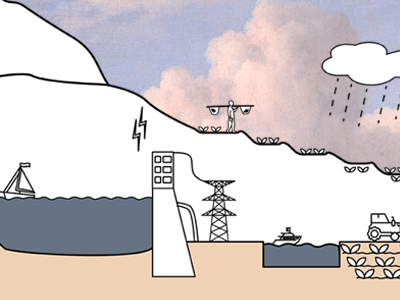Overview
Learn from the experience of the Netherlands-based "Room for the River" program devising sustainable river and delta solutions in times of climate change.
With a long history of disasters and years of dealing with the challenges posed by water, the Netherlands has accumulated essential knowledge about water management and specifically of rivers. This course will share with you this knowledge gleaned over more than a decade under the Dutch government’s “Room for the River” program, started in 2007. The goal of this program was to manage higher water levels in rivers, while restoring the river’s natural flood plain in places where it is least harmful in order to protect those areas that need protection. All this in the context of the changing characteristics of rivers in times of climate change.
While the practical experience gained from this program is derived from cases in the Netherlands, it also applies to other countries that build their social, ecological and economic prosperity on what rivers bring them. It will be most beneficial for water managers, river engineers, landscape designers and policy makers who seek more knowledge surrounding analysis, design and development of river and delta solutions.
The specific skills gained in this course are in the design of engineering interventions; stakeholder analysis and balancing economic benefits with safe living conditions, ecological quality and attractive landscapes. You will also understand the impact of climate change and will be introduced to approaches to deal with the long-term dynamics and uncertainties that rivers bring.
We offer you the opportunity to learn from our experiences and apply it on your own river and we also aim to learn from you. The course is structured as an exchange, with a strong focus on analysis and design.
What You'll Learn:
- To examine a river (watershed) and a problem area (project level) from the perspectives of hydraulic engineering, governance and landscape design
- Module 1: To investigate a river (watershed) and a problem area (project level) by considering large spatial scales (from source to sea) considering the historical developments and long-term horizons;
- Module 2: To appreciate the different hydrological and hydraulic interventions that can be used to re-design a river considering the topical challenges
- Module 3: To analyse which role various stakeholders play in governance of river systems and basin management processes
- Module 4: To discover the potential role of landscape design in accommodating various societal functions, including water safety, over short- and long-term time horizons;
- Module 5: to understand the intricacies of bringing together water safety, governance and spatial quality aspects into one integrated program with a long-term planning perspective.
Details
Module 1 - Introduction: the river as persona
Scale: Watershed
(Inter)Disciplinary perspective: integrated problem focus
Module 2 - A water safety issue?
Scale: From watershed to project scales
Disciplinary perspective: Hydraulic Engineering
Module 3 - A governance issue?
Scale: Project scale (problem area)
Disciplinary perspective: governance
Module 4 - A spatial quality issue?
Scale: Project scale (problem area)
Disciplinary perspective: spatial design
Module 5 - Room for rivers: an integrated approach
Scale: Watershed
(Inter)Disciplinary perspective: program architecture
Qualifications
Chartered Engineering Competences
All our online courses and programs have been matched to the competences determined by KIVI’s Competence Structure, a common frame of reference for everyone, across all disciplines, levels and roles.
These competences apply to this course:
- A1: Extend your theoretical knowledge of new and advancing technologies.
- B1: Identify potential projects and opportunities.
- E3: Undertake engineering activities in a way that contributes to sustainable development and a circular economy.
Admission
This is a Massive Open Online Course (MOOC) that runs on edX.
Prerequisites
None. There are no prerequisites for participating in this course. Analytical ability, an interest in rivers and an affinity with engineering, governance or landscape design are helpful.

